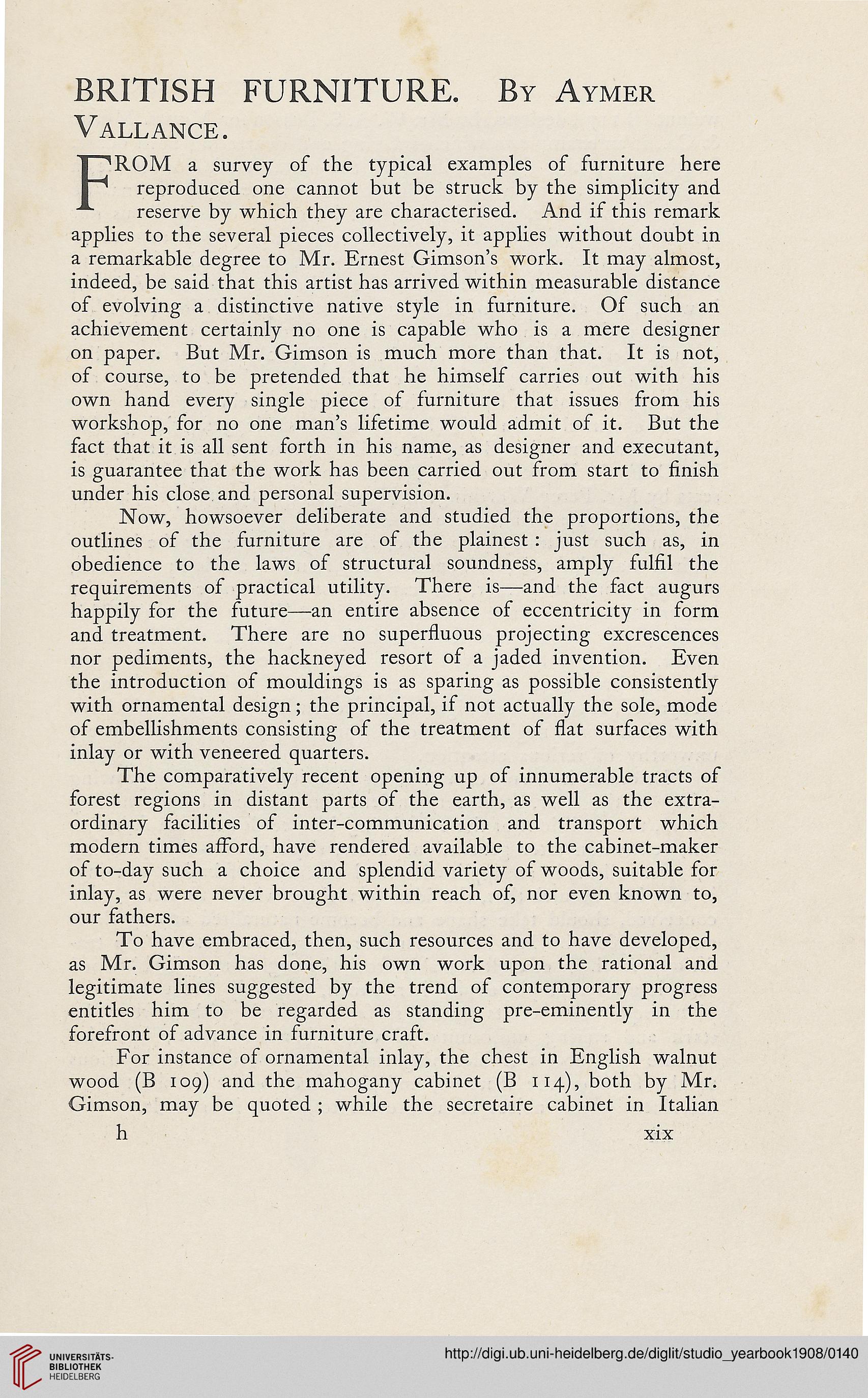BRITISH FURNITURE. By Aymer
Vallance.
FROM a survey of the typical examples of furniture here
reproduced one cannot but be struck by the simplicity and
reserve by which they are characterised. And if this remark
applies to the several pieces collectively, it applies without doubt in
a remarkable degree to Mr. Ernest Gimson's work. It may almost,
indeed, be said that this artist has arrived within measurable distance
of evolving a distinctive native style in furniture. Of such an
achievement certainly no one is capable who is a mere designer
on paper. But Mr. Gimson is much more than that. It is not,
of course, to be pretended that he himself carries out with his
own hand every single piece of furniture that issues from his
workshop, for no one man's lifetime would admit of it. But the
fact that it is all sent forth in his name, as designer and executant,
is guarantee that the work has been carried out from start to finish
under his close and personal supervision.
Now, howsoever deliberate and studied the proportions, the
outlines of the furniture are of the plainest : just such as, in
obedience to the laws of structural soundness, amply fulfil the
requirements of practical utility. There is—and the fact augurs
happily for the future—an entire absence of eccentricity in form
and treatment. There are no superfluous projecting excrescences
nor pediments, the hackneyed resort of a jaded invention. Even
the introduction of mouldings is as sparing as possible consistently
with ornamental design ; the principal, if not actually the sole, mode
of embellishments consisting of the treatment of flat surfaces with
inlay or with veneered quarters.
The comparatively recent opening up of innumerable tracts of
forest regions in distant parts of the earth, as well as the extra-
ordinary facilities of inter-communication and transport which
modern times afford, have rendered available to the cabinet-maker
of to-day such a choice and splendid variety of woods, suitable for
inlay, as were never brought within reach of, nor even known to,
our fathers.
To have embraced, then, such resources and to have developed,
as Mr. Gimson has done, his own work upon the rational and
legitimate lines suggested by the trend of contemporary progress
entitles him to be regarded as standing pre-eminently in the
forefront of advance in furniture craft.
For instance of ornamental inlay, the chest in English walnut
wood (B 109) and the mahogany cabinet (B 114), both by Mr.
Gimson, may be quoted ; while the secretaire cabinet in Italian
h xix
Vallance.
FROM a survey of the typical examples of furniture here
reproduced one cannot but be struck by the simplicity and
reserve by which they are characterised. And if this remark
applies to the several pieces collectively, it applies without doubt in
a remarkable degree to Mr. Ernest Gimson's work. It may almost,
indeed, be said that this artist has arrived within measurable distance
of evolving a distinctive native style in furniture. Of such an
achievement certainly no one is capable who is a mere designer
on paper. But Mr. Gimson is much more than that. It is not,
of course, to be pretended that he himself carries out with his
own hand every single piece of furniture that issues from his
workshop, for no one man's lifetime would admit of it. But the
fact that it is all sent forth in his name, as designer and executant,
is guarantee that the work has been carried out from start to finish
under his close and personal supervision.
Now, howsoever deliberate and studied the proportions, the
outlines of the furniture are of the plainest : just such as, in
obedience to the laws of structural soundness, amply fulfil the
requirements of practical utility. There is—and the fact augurs
happily for the future—an entire absence of eccentricity in form
and treatment. There are no superfluous projecting excrescences
nor pediments, the hackneyed resort of a jaded invention. Even
the introduction of mouldings is as sparing as possible consistently
with ornamental design ; the principal, if not actually the sole, mode
of embellishments consisting of the treatment of flat surfaces with
inlay or with veneered quarters.
The comparatively recent opening up of innumerable tracts of
forest regions in distant parts of the earth, as well as the extra-
ordinary facilities of inter-communication and transport which
modern times afford, have rendered available to the cabinet-maker
of to-day such a choice and splendid variety of woods, suitable for
inlay, as were never brought within reach of, nor even known to,
our fathers.
To have embraced, then, such resources and to have developed,
as Mr. Gimson has done, his own work upon the rational and
legitimate lines suggested by the trend of contemporary progress
entitles him to be regarded as standing pre-eminently in the
forefront of advance in furniture craft.
For instance of ornamental inlay, the chest in English walnut
wood (B 109) and the mahogany cabinet (B 114), both by Mr.
Gimson, may be quoted ; while the secretaire cabinet in Italian
h xix




